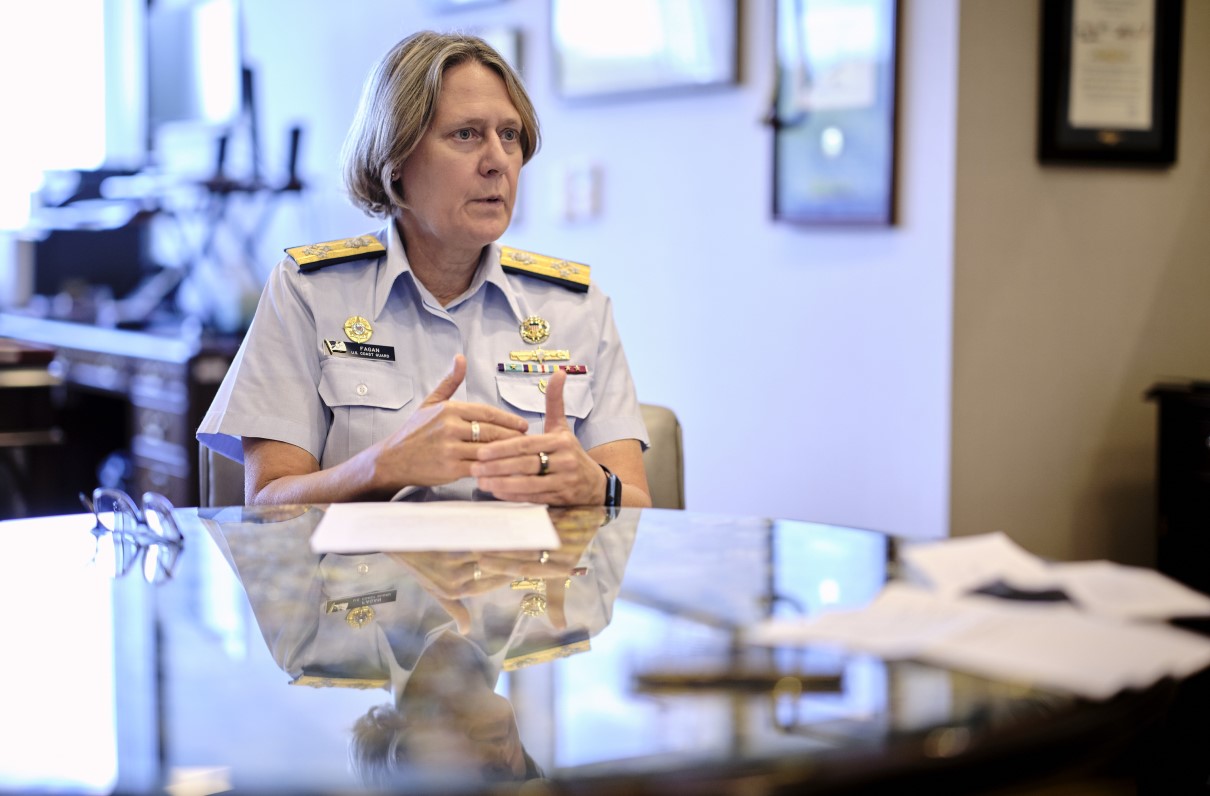(This article originally appeared in the December 2022 issue of Military Officer, a magazine available to all MOAA Premium and Life members. Learn more about the magazine here; learn more about joining MOAA here.)
As Linda Fagan rose through the ranks during her 37 years in the Coast Guard, she often walked past the portraits of previous maritime leaders in the Hall of Commandants.
After being named commandant in June, Fagan no longer needs to take that route to get to her new office. Instead, the first female commandant is charting a new path for those who want to work on the world’s waterways.
Military Officer spoke with the history-making former vice commandant and executive assistant to the commandant. Fagan discussed topics ranging from her plans to transform the Coast Guard talent base to the branch’s presence in the Arctic.
The following interview has been edited for length and clarity.
Q. There is an expected 25% shortfall in recruitment this year. What ways can you encourage more individuals to serve?
A. We are experiencing some of the same recruiting challenges as the other services. … We’re moving resources and focusing specifically on recruiting. … It’s a high-contact endeavor, and it takes just a lot of one-on-one engagement.
[MOAA INTERVIEW: Army Secretary Christine Wormuth on the Future Force, Recruiting Woes, and More]
One of the good news stories here is I don’t have a retention issue. So once ... they join, we have good luck in keeping them. One of my strategic priorities is around transforming our talent management system. … We fundamentally run an up-or-out system where you enter at the bottom and [are] forced forward at a steady pace. I don’t believe that system serves us well now. And I know it won’t serve us well into the future as we look at recruiting individuals who have a propensity to serve. And so any and all policy changes are on the table right now as we look at making it easier for people to join the military.
Q. How do you make sea duty more attractive knowing that many go away for months at a time?
A. So we have a sea duty attractiveness workforce task force going on right now, to look at any and all tools and policies to ensure that we make sea duty attractive. What I hear consistently from crews is, "we love being underway." The work underway is meaningful, whether it’s in the migrant realm, interdicting narcotics, icebreakers in the Arctic and Antarctica. People like the work, it’s meaningful work, and they love the camaraderie.
But time after time when that ship comes into home port and we go into a heavy maintenance cycle, that’s the pace that’s really making it difficult for us. And so we’re looking at how do we improve … the in-port experience, to have some time to refresh with their families. Also pretty consistent is just bandwidth and access to communication tools. People want to stay in touch with their families, and we’ve made some great progress there. We continue to look at how we [can] make it easier for people to serve at sea.
[MOAA INTERVIEW: Air Force Secretary Frank Kendall on Preparing for the Next 75 Years]
Q. What do you hope being the first female commandant represents to younger generations?
A. Representation matters, seeing women serving now at every level in the organization is a powerful signal of the opportunity that we provide. My daughter graduated from the Coast Guard Academy in 2016. … She joined the Coast Guard… that already looked very different than the Coast Guard that I joined. I graduated in 1985, [and] there were 5% women in my class. By contrast, the class of 2026 … is 43% women.
Q. In what ways do you hope the Coast Guard improves under your watch — from technology, quality of life, and talent-management standpoints?
A. I’ve talked quite a bit about talent management, transforming our fundamental assumptions around talent management. [That means] finding opportunities for people to lateral[ly move], accepting civilian credentials so that you come in at a mid-grade point and serve, making it easier for people to enter the service, stay in the service, and move between active duty and reserves. If I accomplish nothing other than that, that will be absolutely foundational to the future of the Coast Guard.
[MOAA INTERVIEW: Navy Secretary Carlos Del Toro on Establishing Excellence]
If we don’t do it, I don’t have the workforce that I need to operate the state-of-the-art new acquisitions that we’re bringing online. I want to see a Coast Guard where we’re more nimble in how we ingest technology. We have work going on around the data that we already are creating. And so getting a governance structure around data becomes foundational to being able to use AI and machine learning and predictive analytics, all technology that’s out there now.
Q. How has the reemergence of Russia changed the way the Coast Guard is operating in the Arctic?
A. I was [in Alaska] for … the ribbon cutting to the Arctic Security Center. That’s a good example of the kinds of investments, climate investments, that the United States is making in the Arctic. ... As it pertains to [the] maritime boundary line that we share with Russia, there is almost daily dialogue between the Coast Guard and Russians with regard to our fishing fleet, their
fishing fleet, ensuring that both are in compliance with the rules and norms. And it’s a normalized pattern of behavior, which I actually find encouraging. We are [also] on budget for [acquiring more] polar security cutters. We’re an Arctic nation, and generating presence in the Arctic is critical.
[MOAA INTERVIEW: Meet the Head of NOAA’s Commissioned Officer Corps]
Q. Women in the Coast Guard are making real strides, as evidenced by the successful efforts to increase the number of women serving on small cutters.
In what other ways can the Coast Guard provide opportunities for women?
A. [On] the vast majority of our cutters, the crews are fully co-ed and integrated. The waterway commerce cutters, which are the cutters that worked on our inland rivers, they’re 50, 60-plus years old, and a handful of those still only accommodate all-male crews. We’ve been working to address that. It is inconsistent with a diverse workforce to have units where you cannot accommodate mixed gender crews.
We’ve also stood up … an advocate within our assignment process to help women who want to go to sea, to find billets and berths that are compatible
with where they want to be and where they are in their careers.
PREMIUM Membership Comes With So Many Benefits. Are You Taking Full Advantage?
Find out just how many benefits are waiting for you, and start using them TODAY.

